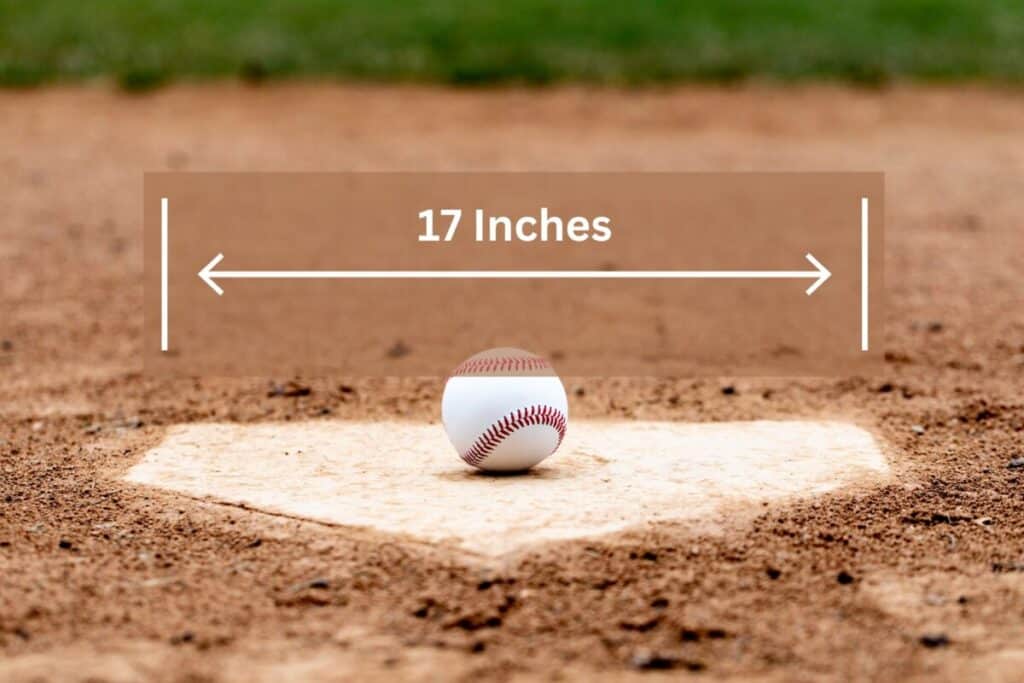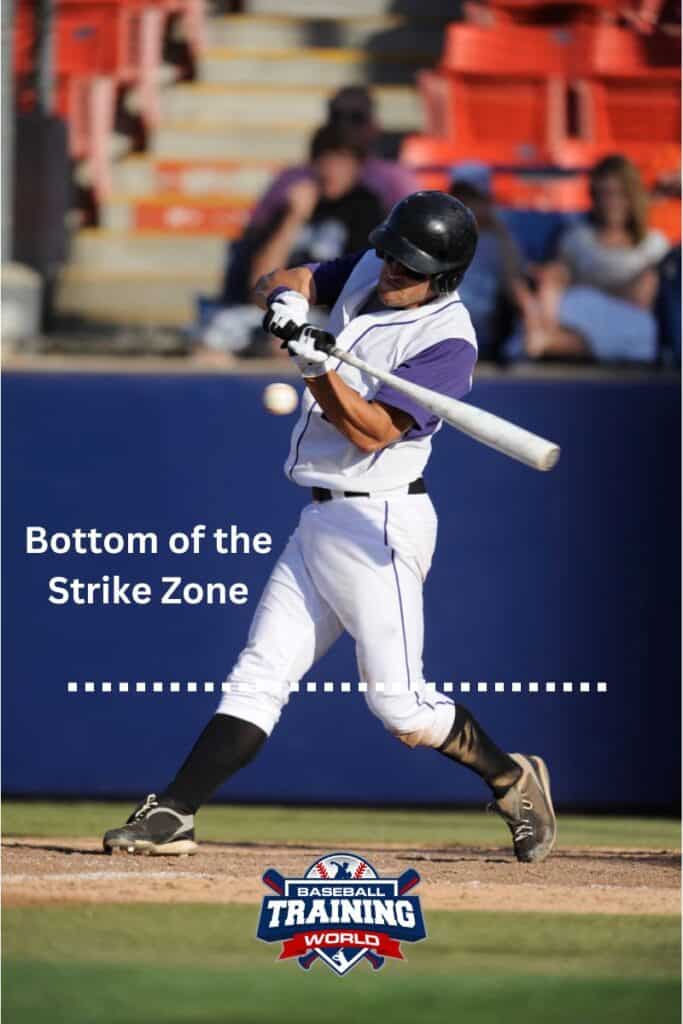During one of my baseball games, the pitcher threw me a pitch I thought was too low to be a strike, but the umpire yelled something that sounded like “strike!”. I turned to the umpire and I asked if he called that a strike. He replied, “Yes. Did you think that was a strike?” I knew players easily get called for arguing balls and strikes so I replied “Um…no comment.”
Luckily, the umpire laughed at my response, but these mini-arguments between hitters and umpires on what is a strike and what isn’t a strike have been going on for decades. So I wanted to write this article to help others understand the technical definition on what is the strike zone in baseball.
In baseball, the strike zone is 17 inches wide while the height of the strike zone is between the bottom of the hitter’s knee and the midpoint between the batter’s shoulders and the top of their pants. The strike zone is set when the batter is preparing to swing.

Don’t worry if the strike zone seems complicated. Let’s dive into the different components of the strike zone.
Article Contents
- The Strike Zone Explained
- Does the Strike Zone Change Based on Height?
- How High Off the Ground is the Strike Zone?
- What is the Average Size of a Strike Zone?
- MLB Strike Zone Changes
- The Strike Zone in Little League
The Strike Zone Explained

The Strike Zone is Determined When the Batter Begins Their Swing
This rule might be a bit of a shock to even the most veteran of players. When watching baseball on TV you sometimes get to see the strike zone of the hitter, but the strike zone is usually set in place before the batter begins their swing.
It’s natural for a lot of players to assume the strike zone is set when the batter takes their batting stance, but it turns out that it doesn’t matter how the batter takes their stance. What matters is how the batter begins their swing.
“The STRIKE ZONE is that area over home plate the upper limit of which is a horizontal line at the midpoint between the top of the shoulders and the top of the uniform pants, and the lower level is a line at the hollow beneath the kneecap. The Strike Zone shall be determined from the batter’s stance as the batter is prepared to swing at a pitched ball“
– Official MLB Rulebook
This rule means that the strike zone is set once a batter is about to swing at the ball. So the umpire will decide as to where the strike zone is located, but that decision is based on how each player begins their swing.
For a great explanation of the strike zone, check out the video below.
The Width of the Strike Zone is 17 Inches
The width of the strike zone extends from one edge of home plate to the other edge of home plate. In both baseball and softball, home plate is always 17 inches wide so the strike zone is always 17 inches wide.

A strike will be called whenever any part of the ball touches any part of home plate. This may sound simple enough, but for an umpire to judge whether a pitch is a strike or ball they have to draw an imaginary vertical line in their head from each edge of home plate.
If the ball touches that imaginary line and the ball has the correct height, the pitch is a strike. If the ball falls outside of that imaginary line or it does not have the correct height, then the pitch is a ball.
Another aspect that can make it more challenging for umpires is the speed at which the pitcher is throwing. Major League pitchers frequently top out at over 90 mph for their fastballs. This means umpires have very little time to judge whether the pitch falls inside the strike zone or outside of the strike zone.
The Height of the Strike Zone is Determined By Player Height and Batting Approach
Due to how each batter has a unique approach to hitting, the height of the strike zone will vary slightly from batter to batter.
Because of the uniqueness of each batter’s approach, the rules allow the umpire to be flexible when it comes to determining the height of the strike zone. Let’s take a look at what each of those height factors are for the strike zone.
The Bottom of the Strike Zone is the Hollow Below the Knee

A strike will be called when any part of the ball is over the plate and is as high as the hollow below the knee. The “hollow below the knee” is that shallow depression that’s located at the back of your knee.
Essentially, this means that an umpire will draw an imaginary horizontal line from the back of the batter’s knee to determine the bottom of that batter’s strike zone. If the ball is over the plate and the ball touches any part of that imaginary horizontal line, then it is called a strike.
The Top of the Strike Zone is the Midpoint Between the Batter’s Shoulders and the Top of the Batter’s Pants

To find the top of the strike zone, the umpire will draw an imaginary horizontal line. But to find the height of that imaginary line, the umpire must first determine the midpoint between the top of the batter’s pants and that batter’s shoulders.
Once the umpire knows the midpoint between the shoulders and top of the pants, which is typically just below a batter’s chest, the umpire will be able to draw that imaginary horizontal line across the plate.
If a pitched ball touches any part of that imaginary line and the ball is over the plate, the umpire will call a strike.
Strike Zone Height is Set When the Batter Prepares to Swing
To add on to the complexity for the umpire, the strike zone isn’t set until the batter begins their swing.
To determine the height of the strike zone, the umpire must determine when the hitter begins their swing and then judge the height of the strike zone.
The way the batter sets up in the batter’s box can give an umpire a pretty good indication of where the strike zone will be, but the umpire won’t know the actual height of the strike zone until the batter starts to swing.
Does the Strike Zone Change Based on Height?
The dimensions of the strike zone vary from batter to batter and one of the biggest differences is the height of each batter.
Since the height of the strike zone is determined by where the batter’s knees, shoulders, and top of the pants are located, the strike zone allows for the umpire to be flexible on the height of the strike zone for each batter.
A 6-foot baseball player will have a taller strike zone than a 5-foot batter because the 6-foot baseball player is taller.
Even though the width of the strike zone will never change, the height of the strike zone will vary from hitter to hitter.
How High Off the Ground is the Strike Zone?

The bottom of the strike zone is 18 to 19 inches off of the ground for the average adult baseball player.
The bottom of the strike zone is determined by the hollow behind the knee of the batter so the height of the strike zone will change from batter to batter.
Because Little League players are typically smaller in size, Little League players can expect the bottom of their strike zone to be a little lower than 18 to 19 inches off of the ground.
What is the Average Size of a Strike Zone?
After learning a bit about the strike zone and the different factors surrounding the strike zone, one might be wondering what an average-size strike zone is. I was wondering the same thing so I took some measurements using my own batting stance.
The average size of the strike zone for a 5′ 8” baseball player is 17 inches wide and 28 inches in height.
Since the width of the strike zone is the width of the plate, the width will always be 17 inches.
The height of the strike zone can change based on each hitter’s approach to the plate, but if you’re looking for an average then 28 inches for a 5′ 8” baseball player is a pretty good starting point.
MLB Strike Zone Changes
The strike zone might seem like a concept that doesn’t need to be changed, but it turns out the strike zone has changed a lot since baseball was invented.
According to Baseball Almanac, the strike zone for the Major League in 1887 was originally set to be a pitched ball that passed over home plate and was between the shoulders and knee.
This strike zone rule was adjusted in 1950 when it was adjusted to be between the batter’s armpits and the top of the knees. The strike zone was also set when the batter took their normal batting stance.
In 1963, the strike zone rule was adjusted again. The strike zone was expanded to be a pitched ball that crosses home plate and is between the batter’s shoulders (as it was before 1950) and the top of the knee. Also, the strike zone was now set when the batter began to swing at a pitch.
In 1969 the strike zone was modified so the top of the strike zone was now back to being at the batter’s armpits and top of the knee.
1988 is the strike zone rule change that makes the rules look closer like what we see today. In 1988, the strike zone was still any pitched ball that crosses home plate, but the height of the strike zone was now between the top of the batter’s knee and the midpoint between the batter’s shoulder and the top of their pants.
In 1996 the strike zone was edited once more so the bottom of the strike zone moved from the top of the knee to the bottom of the knee (hollow beneath the knee).
The Strike Zone in Little League

Much like in other leagues, the strike zone in Little League is a hotly debated topic – especially among parents who are watching the game.
The strike zone in Little League is a bit different than in other leagues. According to LittleLeague.org, the definition of the strike zone is “that space over home plate which is between the batter’s armpits and the top of the knees when the batter assumes a natural stance. The umpire shall determine the strike zone according to the batter’s usual stance when that batter swings at a pitch.“
So in the Major Leagues, the strike zone is determined to be between the hollow behind the knee and the midpoint between the batter’s shoulders and the top of the batter’s pants. In Little League, the strike zone is determined to be between the batter’s armpits and the top of their knees.
This means that the strike zone is slightly larger in Little League (when comparing the area of the strike zone in relation to the size of the batter). If a pitched ball was thrown at the armpits, it would be a ball in Major League, but it would be a strike in Little League.
10 thoughts on “Understanding the Strike Zone in Baseball”
Comments are closed.